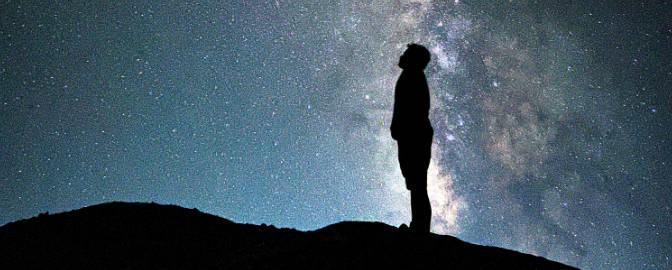ANSMET team • Jan 13, 2009
The Antarctic search for meteorites: bad days make for more blog fodder
January 9-13, 2009
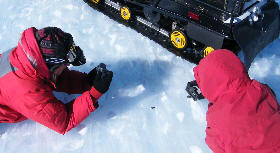
Amy and Jani photograph one of many meteorites to document its appearance in the field.
ANSMETMay the muse be with you...it's not with us
January 9, 2009
Well ladies and gentlemen, boys and girls, writer's block has hit ANSMET. Hopefully, it will be only a temporary problem.
Coming back from a great day of collecting - we returned to The Meteorite Zone today and bagged another 60 meteorites - I began trying to think of something to put in the blog. I suddenly realized my mind was a total blank. I could not think of anything that our faithful public could possibly want to read.
Back at camp I inquired of the others. Amy and Jani thought they could do something in the next few days. Deon did not have anything in mind. I did not ask Joe because he has already admitted that the poo tent and snowmobiles are the only things he knows about. I'll work on John, but from past experience (in 2001) it takes many days to arm wrestle him into writing a blog.
Sorry folks. Stay tuned tomorrow.
100 years ago this date: At last the blizzard ended. Shackleton's team got up at 2 AM, got ready and at made their dash to the south at 4 AM. At 9 AM they reached 88 degrees 23 minutes south latitude, a scant 111 miles from the Pole. After a brief ceremony and photo taking, they turned north and began the long return journey to Britain.
Cheers,
LYAN
duck
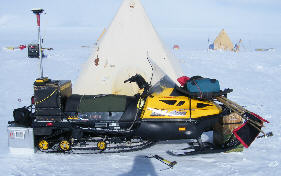
John's ski-doo up on blocks
Next to the poo tent, in the "White Trash" part of Davis-Ward camp.ANSMET
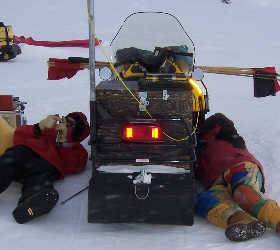
Using the appropriate tools and choice words, John and duck replace a broken spring.
ANSMETMother Nature and Murphy's Law* conspire against us
January 10, 2009
The day started out a bit "iffy." During the night the winds came up, but they were not too bad in the morning. It was about -17 C (+2 F) when we got up, but the temperature dropped to -20 C (-4 F) within about half an hour. And there was a thick cloud bank to the northeast, a possible harbinger of bad weather. Nevertheless, we decided that we would try sweeping the ice southeast of camp at the base of Mount Ward where we had left off the day before.
One thing we have learned about this location is that the winds there have been stronger than those back at camp, even though it is only about 4 kilometers (2.5 miles) away. Our first sweep, into the teeth of the wind, was not my most pleasant Antarctic experience. (But neither was it my least pleasant.) When we reached the upwind end, John suggested we turn, do a downwind sweep and consider the possibility of quitting for the day. In spite of the adverse conditions, some members of the team expressed the hope that we could continue working.
That is when Murphy's Law was enforced. We had just about reached the end of the downwind sweep when John's ski-doo coughed-up a small metal rod. Nothing important, just a piece of one of his springs. With a suspension in danger of collapse, John on his ski-doo limped back to camp, accompanied by his faithful posse. There, we would effect repairs. John opined that it was a half-hour repair job - IN a properly heated and equipped repair shop. He guessed it would take us two hours. In long-standing ANSMET tradition, ski-doo repairs are always done on the windiest of days to enhance the enjoyment. Today's wind chill was about -40 C (also -40 F).
After warming ourselves in our tents and having a hot lunch, John, Jani and I went to work. The ski-doo was parked in the lee of the poo tent to provide some measure of protection from the winds, put up on blocks, and attacked with a variety of tools. Joe came to offer encouragement, and to use the poo tent. In much use during this period were a variety of words which I will put down here as "Gosh Darn It!", "Dag Nabbit!", "Shucks!" and "Son of a Gun!" Also, there was much discussion about whether the design engineer's parents had ever wed.
Finally, after replacing the broken spring, we put it all back together. Much to our surprise, there were no leftover parts lying in the snow. And it only took us two and a half hours!
Even with these natural and man-made impediments, we managed to collect 14 meteorites today.
Message to Ralph: Please include a fully staffed, heated, deep-field ski-doo repair shop on the next ANSMET "required logistics" list.
100 years ago this date: Shackleton and party are making their way back north. The winds stripped the flags they had left to mark their route, but fortunately, they were able to follow their tracks. It was hard going, but they made just over 21 miles.
Cheers,
LYAN
duck
*Law of low expectations: the law or principle that if anything can go wrong, it will.
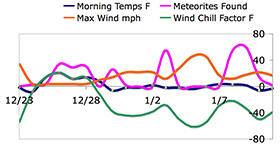
Graph of day-by-day weather conditions and meteorites collected.
ANSMET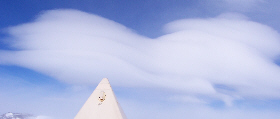
Large lenticular cloud south of camp indicates strong winds in our future.
ANSMETSo...just how cold does it get?
January 11, 2009
It feels appropriate to write a weblog on the weather this week, since out of the last seven days, we've had three half days, two tent days, and only two full days of work. Today we warmed ourselves in the tent after a brief and brisk morning of collecting in wind and low temperatures. We may have tried to muscle through the rest of the day, but we finished off the ice field northwest of camp, and the next logical target - The Meteorite Zone - was totally obscured by blowing snow when we got back to camp. That kept us tent-bound for the rest of the day.
We have mentioned, I'm sure a time or two, that we are on the highest, coldest, and driest continent on Earth. But what does that mean for us in terms of living and working here? We have probably flung out to you measured temperature values like -5 F (Fahrenheit), but you Midwesterners reply with "gosh, we were sweating with those highs back in aught-six" or similar. What really makes or breaks a day of searching is not so much the measured temperature alone as it is that plus the wind. Wind is everything. In the included graph is a set of figures obtained from my little Sper Scientific handheld weather gauge (checked against Johnny's more sophisticated equipment): Morning temperatures in degrees F (measured with a thermocouple strung outside the tent), maximum wind measured for the day in miles per hour, the wind chill factor in degrees F, and numbers of meteorites found that day.
Notice the numbers of meteorites found, and thus the amount of time we spent outside, is much more dependent on the wind speed than the measured temperature. Changes in wind speed also dramatically affect the wind chill factor. Wind chill is a sensory value, meaning it is something you feel rather than measure, and is derived from numerous experiments and calculations. Wind chill is related to the fact that skin has lots of water in it, and that wind is effective at evaporating (or sublimating) this water away, making you cool off much faster than if there were no wind. Thus, our skidoos may only be sensitive to the outside temperatures of -5 F, but if the wind is blowing at 22 miles per hour, like it was yesterday, our little faces and hands feel temperatures of nearly -50 F. Hands perhaps suffer the most, as we bare them while collecting. Hence, it may be hard for Antarctic summer measured temperatures to ever be low enough to keep us in the tent, but the winds can do it at their whim.
Other kinds of weather can also keep us from collecting meteorites. Low, dark, storm clouds decrease visibility, making it hard to discern meteorites from meteor"wrongs". Currently, we're on the edge of storm three of the season, all of which have brought some snow. Thankfully, winds blew while the snow fell, preventing it from settling and covering up the meteorites. Thanks to Johnny, we're learning how to read the Antarctic skies to help us predict the weather. Low, dark clouds often bring snow and fog, while clear skies all around are good but can often mean strong, cold winds from the south.
Lenticular clouds, large, oblong or lens-shaped features, are becoming regulars in our skies, and also herald strong, cold winds from the south. When air approaching from the east reaches the mountains, where we are, and gets uplifted, the air cools and any water contained in it condenses into clouds. These are really beautiful, and can be stretched out into wavelike forms or chaotic strings, under really high winds. Lenticulars may be beautiful, but they can also spell an approaching end to a search day.
We continue to be amazed at the ever-changing, spectacular, and a little bit scary, weather on the fringes of the Antarctic Plateau.
100 years ago this date: Shackleton and his men are making rapid progress to the north. There are strong winds and the temperature is -15 F. By following their sled tracks they make nineteen and a half miles toward Ross Island.
- Jani

Deon eats lunch hunched behind his ski-doo to keep out of the wind.
ANSMET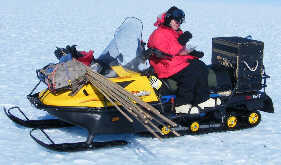
Amy eats lunch sitting proud and tall on her ski-doo; screw the wind.
ANSMETOh what a beautiful morning...
January 12, 2009
We woke up to a beautiful day. The thermometer read -19 C (-2 F). There was but the faintest of breezes, and the sky was mostly free of clouds. If you looked at the graph in yesterday's post, you will recognize this as perfect weather for meteorite hunting. So off we went at the usual time, 09:00.
We headed out to the ice field at the base of Mount Ward with the expectation that a bumper crop of meteorites would be harvested. We started off with a sweep upwind toward The Meteorite Zone. As has been common the last few times we have been out, winds below Mount Ward are stronger than they are at back at camp. Nevertheless, it was good hunting and the space rocks began to fall into our dragnet.
After the sweep, we went to foot-searching in The Meteorite Zone. More meteorites were captured. During this foot-search, the winds began to pick up, and we began to chill. Lunch was in the wind, each of us handling it in our own way.
After lunch, another foot-search in The Meteorite Zone (with lower winds), and another ski-doo sweep (with little wind). The haul for the day was 65 meteorites. Included in the bunch is a beautiful achondrite that I estimate masses just over one kilogram (over two pounds). (An achondrite is a meteorite that was formed by magmatic processes on an asteroid.) All-in-all, a very good day for the team.
100 years ago this date: Now that Shackleton's party is going north, they want the katabatic winds to come up to help push the sledges along. Unfortunately for them, the day was calm, and they faced difficult sastrugi. Even so, they made 16 miles of progress on their return trek.
Cheers,
LYAN
duck
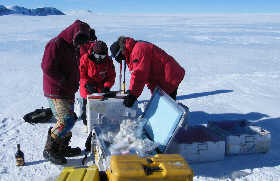
The Gang of Four inventory our meteorite harvest.
ANSMETCamp chores and meteorites hunting
January 13, 2009
Every now and then, you just have to take care of chores. Field work with ANSMET is no exception. It was relatively mild when we got up. The temperature was -17 C (+2 F) and there was only a light wind. We decided to take advantage of the clement conditions and take care of some chores around camp before we went out to hunt more meteorites.
One of the things we do is inventory the meteorites that we have collected. After yesterday's take, our total for the season stood at 378 meteorites, and it was time to verify the total. We go through the list of field numbers from John's notebook and physically find each rock, identifying it by the field number tag visible for each wrapped meteorite. They are then organized by field number into labeled bags, and put away for shipping. Happily, we put our mitts on all 378 wrapped samples, so nothing is amiss with our harvest. Amy, Deon and Jani, with help from John, handled this chore.
While they were doing that, I put together the container of special materials that the folks at Johnson Space Center, primarily Cecilia, will need in order to begin processing the samples.
There is only a little over a week left in the field season. John and Joe organized materials we will no longer need and the accumulated trash, and hauled it out to the skiway for pick up. We are hoping a Twin Otter or Basler returning to McMurdo from The Pole will be able to stop and pick this up before we start pulling out of the field. That will cut down on the number of flights we will need to get us and all our gear back to McMurdo at the end of the season.
After the chores were done, we went back to the area at the base of Mount Ward to increase our total. As usual, the winds there were much stronger than back at camp. We did one ski-doo sweep of the ice field, and one section of foot searching in The Meteorite Zone, and then decided to make it an early day. You may understand this decision based on the fact that the wind chill was -40 C (also -40 F). In that short time, we bagged another 26 meteorites, upping our total to 404. It was a productive, if short, day for the team.
ANSMET haiku:
Cold little space rock
Hiding among the Earth rocks
We'll get you sucka!
100 years ago this date: Shackleton and his explorers made over 17 miles, partly with the help of katabatic winds pushing on a sail on the sledge. The temperature was -18 F. Frostbite is a continuing problem and Shackleton has frost-bitten heels! Food is running short; they need to make tracks to the next depot.
Cheers,
LYAN
duck


 Explore Worlds
Explore Worlds Find Life
Find Life Defend Earth
Defend Earth